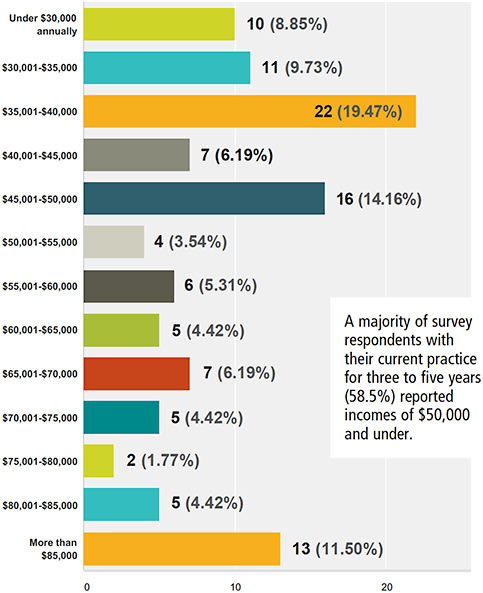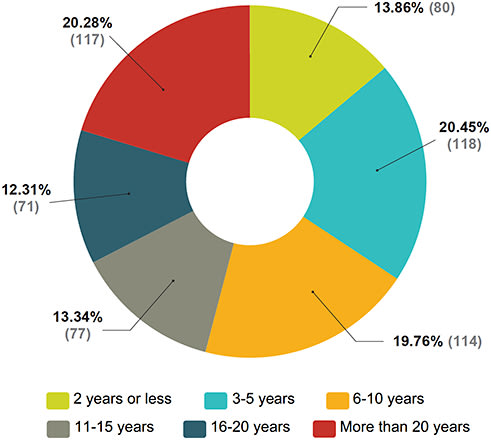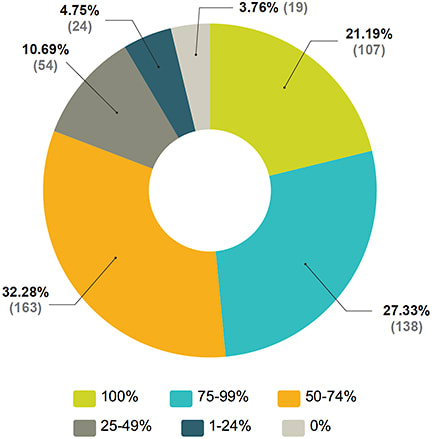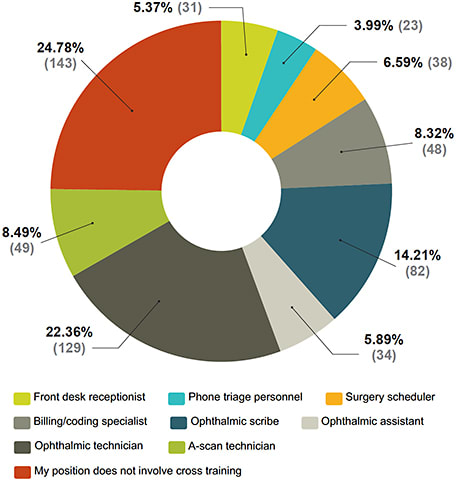2nd Annual Readership Study
The road to a rewarding career
Our second annual subscriber survey details the paths that OP readers have paved.
BY ZACK TERTEL, MANAGING EDITOR
In our first annual Ophthalmic Professional subscriber survey, we learned a great deal about our readers. This year, we listened to some of your suggestions regarding how to improve the survey. After gathering the results, your answers gave us an even clearer answer to the question: “Who are the OP subscribers?”
Here, industry experts share their takeaways and what the results say about the ophthalmic profession.
Survey methodology
The Ophthalmic Professional Subscriber Survey was conducted earlier this year. Subscribers were sent four separate email invitations to participate in the online survey, beginning on April 6. The survey closed May 7. As an incentive, respondents were entered in a drawing for an iPad Air 2, which was won by Rhonda Horiuchi, COA, of Halpern Ophthalmology Associates. After removing duplicate responses, Ophthalmic Professional received a total of 577 responses. All individual survey responses are confidential.
Longevity
Perhaps the most significant change to this year’s survey involved questions of OP subscriber’s longevity. We asked how long subscribers worked in an ophthalmic-related position, their current practice, and their current position. The results showed that our subscribers are dedicated to both their practices and their profession.
About 52.7% of respondents have worked in ophthalmology for more than 20 years (Figure 1). Bruce Maller, Ophthalmic Professional’s co-editor-in-chief, had conflicting responses to the results. “At first, these data may not feel or sound accurate,” says Mr. Maller, founder and president of BSM Consulting. “But, as I sat back and thought about this, the results are not surprising. Most ophthalmic professionals I meet in my travels find the nature of their work very satisfying.”
Figure 1. How long have you worked in an ophthalmic-related position?
Patti Barkey, COE, considers these years of experience to be a potential advantage for all ophthalmic professionals. She communicates with many practice administrators who have been in the industry for many years and appreciates the opportunity to glean a bit of wisdom from these ophthalmic veterans. “Most of us ‘old timers’ enjoy being able to network and assist each other,” says Ms. Barkey, CEO/administrator of Bowden Eye & Associates in Jacksonville, FL. “There really is no need to reinvent the wheel when someone within our reach is an expert on almost any topic.”
Newer ophthalmic professionals may find it hard to imagine themselves in one field for so long. However, Laurie K. Brown, MBA, COMT, COE, sees ophthalmology as a track to a career, not just a job — for those who put their minds to it. “They (ophthalmic professionals) are highly specialized and have an amazing career path at their feet from their first day,” says Ms. Brown, administrator at Drs. Fine, Hoffman & Sims, LLC in Eugene, OR. “They just have to be self-motivated and bright.”
Along with a dedication to their profession, our subscribers tend to stay with one practice. About 20.3% of survey respondents have been with their practice for more than 20 years (Figure 2). Jane Shuman, MSM, COT, COE, OCS, CMSS, OSC, co-editor-in-chief of Ophthalmic Professional, says this figure is a good representation of the industry. “When I network with different people or I’m in a practice, it’s not uncommon to see people in their 20th and 30th years in the practice,” says Ms. Shuman, president of Eyetechs.
Figure 2. How long have you worked at your current practice?
Beth Hunter, COT, is the clinical manager at Shepherd Eye Center in Las Vegas, NV and has worked at the practice for 25 years. She says many co-workers share her passion for their practice. “I think it is a combination of loving the job, enjoying the place and people you work with, and the ability to grow professionally and financially,” Ms. Hunter says.
Ms. Barkey attributes this longevity to a certain level of competitiveness that keeps ophthalmic professionals engaged and staying at one practice. She and many other administrators take pride in their organizations and manage them like it’s their personal business, she says. “Ophthalmology always has something new that administrators can add to their practice. Growth and development keep us all very busy along with the changes in healthcare. I personally couldn’t walk away from the practice until I felt it was completely organized and maxed out on potential.”
It’s not just administrators and managerial staff who stick with one practice. For technicians and other clinical staff, ophthalmology is a dynamic specialty with many chances to grow, says Mr. Maller. “As a general rule, employees would prefer to stay in their current practices assuming they have opportunities for career advancement and they have a good working relationship with their manager,” he says. “Switching jobs is not preferred unless one’s needs are not being met.”
The opportunities for advancement correlate with our survey results. Those who have been with a practice for a long period of time earn a higher salary than those who are relatively new to the practice (Figures 3 and 4).
Figure 3. Income of those with their current practice three to five years.
Figure 4. Income of those with their current practice 20 years or more.
We also asked how long subscribers have worked in their current position, and the results varied (Figure 5). While more than one third of respondents (34.3%) have been in their current position for five years or less, 20.3% have been in their position for more than 20 years. For those who stay in one position, the reasons may vary. Ms. Shuman says that some technicians may be happy to remain as technicians, while others may work in a small practice with limited chance for progression.
Figure 5. How long have you worked in your current position?
Primary positions
Another change we made to this year’s survey involved refining our question on primary positions. The top-five positions comprised about 73% of all respondents (Figure 6). These positions generally trended from low to high salaries with the following progression: COA, COT, COMT, office manager/administrator, clinical/surgical director.
Figure 6. Top-five categories that best describe primary position.
Along with these increased salaries, managers/administrators and directors indicated that they have greater involvement in the purchase of diagnostic equipment, computing systems, and software systems and meet more often with sales and vendor reps. Ms. Barkey considers this a necessity, as these positions must have control to appropriately manage and get the most out of their physicians and staff. “I often wonder when I see a high-level administrator or CEO who doesn’t seem to have the power to make decisions.”
Career concerns
We asked our subscribers to indicate their greatest concerns in their careers and found that more than half of all respondents worry about the growing complexity of their work load (Figure 7). These feelings grew even stronger for primary positions with higher salaries and more involvement in purchasing decisions. About 59% of office managers/administrators indicated the workload concern, as did about 65% of surgical/clinical directors.
Figure 7. Please indicate your greatest concerns about your career.
“As we try to do more with less, we struggle to find the happy balance for employees,” says Ms. Brown. “In our practice, we have made training much more formalized, which creates more staff support, efficiency, and accuracy. As they are asked to be responsible for more and need to meet even more compliance requirements, they need to be supported with education and training.”
Not all ophthalmic professionals share the same concerns, however. For instance, about 48% of full-time COAs say they lack a clear career path or income growth vs. 30.5% of all survey respondents. Similarly, about 49% of full-time COAs also feel they are inadequately compensated compared to about 34.3% of all survey respondents.
Medical insurance
From our first annual survey last year to this year’s version, we saw some changes in the responses, but few stood out more than the drop in medical insurance paid by the practice (Figure 8). Those who answered 100% dropped from 31% last year to 21% in the second annual survey. Accordingly, the number of respondents who answered “50% to 75%” grew from 25% to 32%. Mr. Maller says this is a vexing issue for all small employers, and that includes medical practices.
Figure 8. What percentage of your medical insurance is paid by the practice?
With the decreases in reimbursement, Ms. Hunter says she is amazed that practices are even able to provide insurance. “We let our staff know that, due to increased premiums and decreased reimbursement, we are doing the best we can for them,” she says.
In addition to higher cost sharing, many employees are also facing the challenges of plans with higher deductible and co-payments, says Mr. Maller. “For many employers, the cost of health insurance has escalated by over 10% in 2016 as compared with 2015. It is difficult for practices to maintain high employee morale in the face of these stark realities.”
As for the impact on team morale, Ms. Shuman says that practices can lessen the blow by offering other benefits to their staff. This can include staff outings and team-building opportunities, increased uniform allowances, casual days, lunches, and rewards such as gift cards for meeting incentives or going above and beyond the expected level of customer service.
Cross-training
Cross-training is essential in ophthalmology. About 75.2% of respondents indicated that they have a position in which they are primarily cross-trained (Figure 9). The most common positions for which respondents were cross-trained: ophthalmic technician and ophthalmic scribe.
Figure 9. Please select the category that best describes the position in which you are cross-trained.
Mr. Maller says that these direct patient care positions tend to be the highest “demand” positions, because they can present significant challenges to a practice if not adequately filled. “It is so important staff members understand the various positions and can fill in where necessary to support their colleagues. The best approach to care is ‘team-based.’ As such, without cross-trained staff, this becomes a more difficult goal to achieve.”
By cross-training clinical staff, Ms. Hunter says that Shepherd Eye Center can interchange staff members whenever needed, when employees are sick or on vacation, for example, without having to increase overhead. “We start our entry level people in visual field testing and then move them to more advanced positions as they learn the basics. It is not uncommon for a technician at our practice to be proficient in two to three positions.”
At a glance
Other survey results included the following:
• Type of ophthalmic practice. About 53.6% of respondents are employed by a private practice. Another 24.6% work in a multi-specialty clinic.
• Primary practice subspecialty. Almost one-third of respondents (33.5%) work in a cataract subspecialty. General (27.7%) and retina (11.1%) rounded out the top three.
• Highest educational degree. Our respondents’ education ran the gamut. Many indicated that they have college degrees (19.2% with a bachelor’s degree, 16% with an associate degree, and 8.5% master’s degree), but this was far from an overwhelming majority. About 25.3% of respondents have completed “some college,” and 10.1% of respondents have their high school diploma or GED.
• Age. More than half of respondents (about 54.8%) were over 50 years old. About 16% were over 60 years old, while only about 4.6% were 30 years old or younger. This likely mirrors the problems with replacing retiring physicians, says Ms. Brown. “We need to be more proactive in supporting staff development by showing off our field at local community colleges, job fairs, etc.” OP
This year, Ophthalmic Professional subscribers have even more access the results of our subscriber survey. Thanks to the support of OP advertisers, our comprehensive survey report is available to download at no cost. Visit our website (tinyurl.com/OPsurvey2016) to view the data, and please tell us what you think. What are your takeaways, and how can we improve this survey to make it even better next year?















